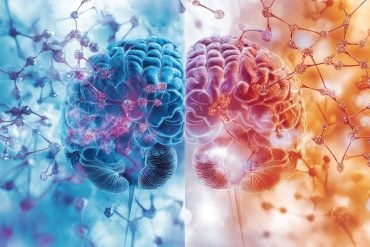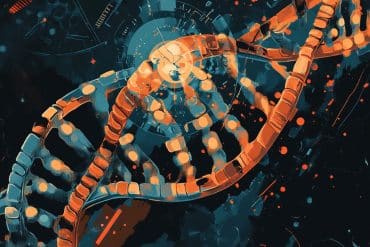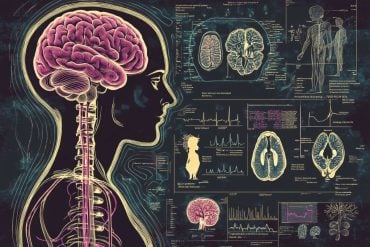Summary: Researchers made a novel discovery about the role of the gut microbiome in activating T cells, which contribute to the development of Multiple Sclerosis (MS).
Using advanced imaging techniques in a mouse model, the team tracked how the gut microbiome activated these cells live for the first time. Activation of the cells crucial for MS development occurred in the gut-associated lymphoid tissue (GALT) within the gut’s mucous membrane, but only when the gut microbiome was intact.
This study provides key insights into MS development and could potentially guide future therapeutic options.
Key Facts:
- For the first time, researchers have observed the live activation of T cells related to Multiple Sclerosis (MS) by the gut microbiome.
- Activation of these T cells occurs in the gut-associated lymphoid tissue (GALT), specifically the lamina propria, but only when an intact gut microbiome is present.
- After activation by the gut microbiome, these T cells differentiate into Th17 cells, which can migrate to the central nervous system and trigger inflammation, a key characteristic of MS.
Source: LUM
LMU researchers have shown that auto-aggressive T cells are activated in a specific area of the intestinal canal – and that activation is microbiome-dependent.
Multiple sclerosis (MS) is an inflammatory autoimmune disease of the central nervous system. It is triggered by certain T cells, which infiltrate the brain and spinal cord and attack the insulating myelin sheath around axons.

In recent years, researchers have found mounting indications that the gut microbiome plays a substantial role in the activation of these cells.
However, the precise location and the underlying mechanisms remained unclear. Using imaging techniques in a mouse model, a team led by Privatdozent Dr. Naoto Kawakami from University of Munich Hospital has now managed to track the microbiome-dependent activation of the cells live – the first time this has been achieved.
For their study, the scientists took an ambitious approach using two-photon imaging for live visualization of the mobility and activation of specific T cells. With a sensor protein, they recorded changes in cellular calcium concentration, allowing them to draw inferences about the activity of the T cells.
The encephalitogenic T cells – that is to say, T cells that can cause inflammations in the brain – investigated by the researchers specifically target a protein in the myelin sheath around neurons and play a key role in the development of multiple sclerosis.
Activation in the lamina propria
As the researchers were able to demonstrate, the requisite for activation of these cells takes place in the so-called gut-associated lymphoid tissue (GALT), which is located in the mucous membrane of the gut, more precisely in the lamina propria, a connective tissue layer of the small intestine.
However, this only happened when the mice had an intact intestinal microbiome: If the gut was microbe-free, activation did not occur.
“Interestingly, activation in the lamina propria seems to be a general mechanism, as even for non-encephalitogenic T cells, which target other molecules in the body, we found that activation depended on the microbiome,” says Kawakami.
The scientists hypothesize that the microbiome produces molecules that are recognized by the respective receptors in the T cells and activate the cells in this way.
In encephalitogenic T cells, the activation turns on genes such that they differentiate into so-called Th17 cells, as the researchers successfully demonstrated. Through this differentiation, the cells develop the properties that enable them to migrate into the central nervous system and trigger inflammations.
“Our results make an important contribution to better understanding the development of multiple sclerosis and potentially open up new therapy options in the long term,” says Kawakami.
This work was performed in close collaboration with scientists in Max Planck Institute of Neurobiology (currently, Max Planck Institute of Biological Intelligence).
About this multiple sclerosis research news
Author: Constanze Drewlo
Source: LUM
Contact: Constanze Drewlo – LUM
Image: The image is credited to Neuroscience News
Original Research: Open access.
“Visualizing the activation of encephalitogenic T cells in the ileal lamina propria by in vivo two-photon imaging” by Naoto Kawakami et al. PNAS
Abstract
Visualizing the activation of encephalitogenic T cells in the ileal lamina propria by in vivo two-photon imaging
Autoreactive encephalitogenic T cells exist in the healthy immune repertoire but need a trigger to induce CNS inflammation. The underlying mechanisms remain elusive, whereby microbiota were shown to be involved in the manifestation of CNS autoimmunity.
Here, we used intravital imaging to explore how microbiota affect the T cells as trigger of CNS inflammation.
Encephalitogenic CD4+ T cells transduced with the calcium-sensing protein Twitch-2B showed calcium signaling with higher frequency than polyclonal T cells in the small intestinal lamina propria (LP) but not in Peyer’s patches.
Interestingly, nonencephalitogenic T cells specific for OVA and LCMV also showed calcium signaling in the LP, indicating a general stimulating effect of microbiota.
The observed calcium signaling was microbiota and MHC class II dependent as it was significantly reduced in germfree animals and after administration of anti-MHC class II antibody, respectively.
As a consequence of T cell stimulation in the small intestine, the encephalitogenic T cells start expressing Th17-axis genes. Finally, we show the migration of CD4+ T cells from the small intestine into the CNS.
In summary, our direct in vivo visualization revealed that microbiota induced T cell activation in the LP, which directed T cells to adopt a Th17-like phenotype as a trigger of CNS inflammation.







